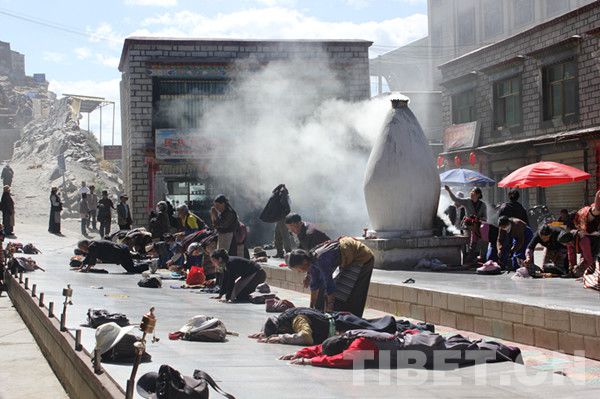
People were prostrating themselves on the ground to make wishes, May 30, 2012 [Photo by Tamdrin Drolma/ China Tibet Online]
The forth month is a holy and auspicious month in Tibetan calendar, marked as the month of "Sagya Dawa", a month-long Tibetan Buddhist festival to commemorate the birth, enlightenment and nirvana of the Buddha Sakyamuni.
It is believed that the virtue of one piece of good deeds in this month equals that of ten thousands; therefore Tibetan Buddhist followers will do various well-doings to accumulate their virtues, including abstaining from killing and eating meat, giving alms to the religious practioners and the poor, taking ritual walks along the traditional path, paying homage to the Buddha, and doing the prostration kowtows.
The Thousand Buddha Cliffside Sculpture, located on the western side of Mount Yaowang (Mount Medicine King, an urban mountain to the right side of Lhasa's Potala Palace), is one of the most popular destinations on pilgrims' ritual walk path along the Lingkor Road.
The large, thick planks in the corridor outside the main hall of Thousand Buddha Cliffside monastery were set for devoted worshippers to do prostration kowtows.
The worshippers put palms together, did namastes three times above the head, in front of the face and to the chest, kneeled down and prostrated themselves entirely on the ground, got up, repeated the set of motion again and again, and made their wishes in front the Buddha statues.
Ngawang, a 50-year-old Tibetan man traveled from hometown to Lhasa every year during the Sagya Dawa Festival, to take ritual walk and pray for the family’s health and well-being.
"My daughter will join the Civil Servants Exam this year, I hope she can do well, so I keep on chanting sutras and praying for her," said the 46-year old Tibetan woman Nyima.
For 26-year old lady Tamdrin, it was her tradition to accompany her grandma to take ritual walk and turn sutra wheels everyday in the period of Sagya Dawa.
On the Lingkor Road, a prestigious and ancient path of ritual walks, the flow of worshippers came and went, with a bag of Tsampa for dinner in the right hand, turning the Buddhist beads or sutra wheels in the left, having no conversation but murmuring the auspicious sutras, and prayed for all living beings and the world.
